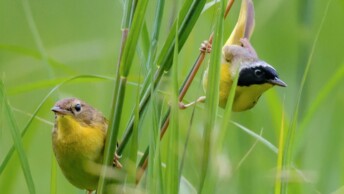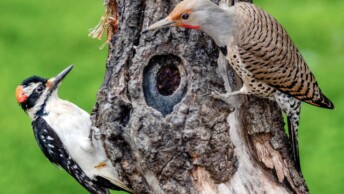Yellow birds are some of the brightest visitors you’ll encounter while birdwatching in Missouri, catching your eye with their vibrant feathers and lively behaviors. From backyard feeders to grassy fields, they’re often easy to spot, especially during spring and summer months. Some, like the cheerful American Goldfinch, are common sights in gardens, fluttering between flowerbeds or feeders filled with sunflower seeds.
Others, such as the Western Meadowlark and Dickcissel, prefer wide-open prairies where their striking yellow chests contrast against the green grass. Warblers and orioles, meanwhile, bring vivid color to wooded areas and streamsides, making birding trips to these habitats especially rewarding.
Observing these yellow birds doesn’t just add visual charm, it also connects you to Missouri’s diverse ecosystems, revealing how different species thrive in specific habitats. In this article, we’ll explore some of Missouri’s iconic yellow birds, highlighting how you can spot and appreciate these feathered gems.
1. American Goldfinch
- Scientific name: Spinus tristis
- Life span: Up to 10 years
- Size: 4.3–5.5 in (11–14 cm)
- Weight: 0.39–0.71 oz (11–20 g)
- Wingspan: 7.5–8.7 in (19–22 cm)
- Status: Least Concern
- State status: Breeding and common
- Migratory behaviour: Mostly stays year-round; minimal migration south.
The American Goldfinch is a bright and cheerful songbird that graces much of North America, from southern Canada through the United States and into parts of Mexico. In summer, males display vivid lemon-yellow feathers offset by a black cap and striking black wings marked with white bars. Females wear softer olive-yellow tones with duller wings, offering a subtler look. During winter, both sexes adopt a muted brownish plumage, blending into dried fields and bare trees more easily.

The American Goldfinch builds its nest later in summer than most songbirds, usually waiting until thistles and other plants have matured enough to provide soft down for lining the cup-shaped nest. Females do most of the weaving, creating a sturdy nest set securely in shrubs or small trees. The structure is so tightly constructed that it can even hold water during rains. Their delayed nesting ensures plenty of seeds are available when their chicks hatch hungry.
Goldfinches primarily eat seeds and are especially fond of thistle and sunflower seeds, which they deftly pluck with their small, conical bills. They will also consume seeds from dandelions, asters, and coneflowers. Unlike many other birds, they rarely eat insects except occasionally for extra protein during nesting. This heavy reliance on seeds makes them regular visitors to backyard feeders, where they eagerly pick at nyjer and black oil sunflower, providing delightful, close-up views for bird enthusiasts.
Historically, the American Goldfinch has remained a widespread and stable species across its range. It has adapted well to suburban environments, often benefiting from gardens and feeders. Because of their healthy numbers and flexible habits, goldfinches are listed as a species of least concern. Conservation efforts mainly focus on maintaining native plant diversity and reducing pesticide use to protect seed sources and ensure their cheerful songs continue brightening fields and neighborhoods alike.
2. Eastern Meadowlark
- Scientific name: Sturnella magna
- Life span: Up to 9 years
- Size: 7.5–10.2 in (19–26 cm)
- Weight: 3.2–5.3 oz (90–150 g)
- Wingspan: 13.8–15.8 in (35–40 cm)
- Status: Near Threatened
- State status: Breeding and common
- Migratory behaviour: Some stay; others migrate south in winter.
Eastern Meadowlarks are widespread in grasslands and prairies east of the Rockies, ranging from southern Canada through much of the United States and into parts of Mexico. They have rich brown streaks across their backs, blending into dry grasses where they often forage. Their bright yellow breasts are marked by a distinctive black V-shaped band, standing out boldly when they sing from fence posts. In flight, they flash white outer tail feathers that help identify them.
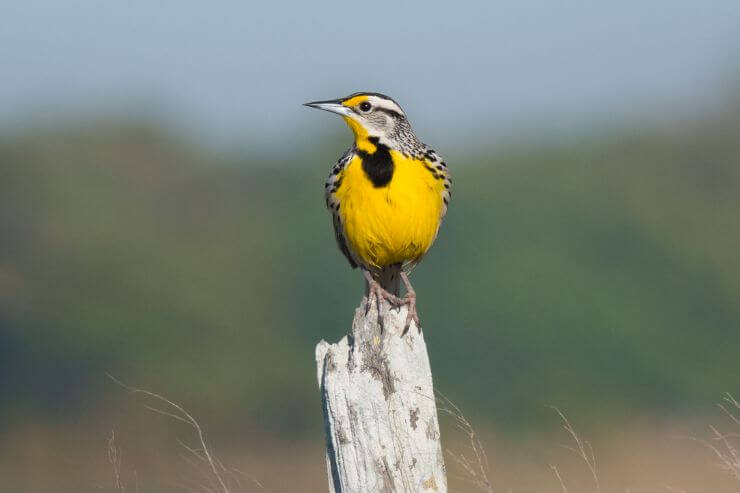
Eastern Meadowlarks build their nests directly on the ground, hidden among thick grasses. The female forms a domed cup of woven stems and lines it with softer grass. An entrance tunnel leads into the nest, helping camouflage the eggs from predators. Males stand sentinel nearby, singing their clear whistles from fence posts. This low nesting makes them vulnerable to mowing and trampling, which can destroy nests before chicks have a chance to fledge.
These meadowlarks rely mainly on insects and other invertebrates during the breeding season. They probe the soil and pick beetles, grasshoppers, and caterpillars from plants. In winter, they shift to seeds and grains scattered across fields. Their mixed diet helps them thrive in farmlands and native grasslands. By consuming many crop pests, they benefit farmers while maintaining the prairie’s natural balance. Watching them forage with slow, deliberate steps is a classic grassland experience.
Historically, Eastern Meadowlarks were abundant across eastern North America’s grasslands. However, their numbers have declined in recent decades as fields are lost to development or intensive agriculture. Conservation efforts focus on maintaining hayfields, meadows, and pastures with delayed mowing to protect nests. Programs encouraging farmers to leave strips of uncut grass have been especially important for supporting local populations and preventing further decline of these iconic prairie songbirds.
3. Prothonotary Warbler
- Scientific name: Protonotaria citrea
- Life span: 4-6 years
- Size: 5.5 in / 14 cm
- Weight: 0.56 oz / 15.9 g
- Wingspan: 8.75 in / 22 cm
- Status: Least Concern
- State status: Breeding and common
- Migratory behaviour: Departs Missouri by August.
The Prothonotary Warbler has a more limited range, favouring the bottomland forests and wooded swamps of Missouri during the breeding season. Its intense golden-yellow body is contrasted by bluish-gray wings and back, creating a striking and elegant appearance. The bird’s clean, almost glowing coloration makes it easy to identify, especially when it flits among branches above slow-moving streams or shaded wetlands. Its strong black eyes stand out against the vivid yellow face, giving it a bright and curious look when observed up close.
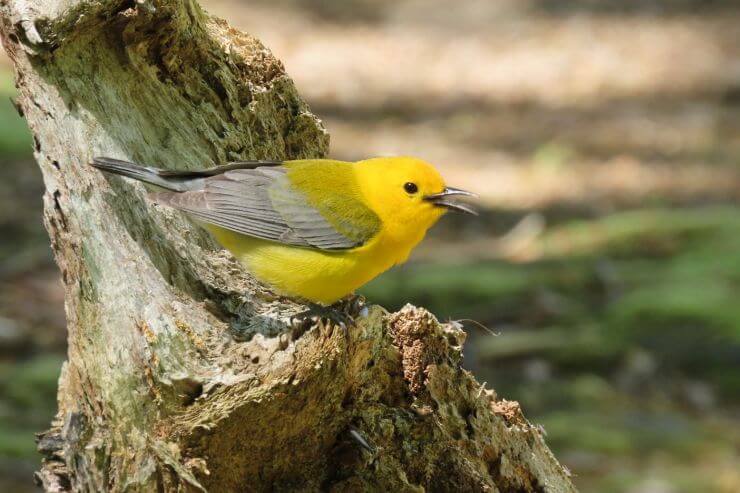
The Prothonotary Warbler often nests in old woodpecker holes or natural cavities low over slow-moving water in Missouri’s swamps and backwaters. Males sometimes place moss in several cavities to attract a female, who chooses the final nest site.
Its diet consists mainly of insects and small invertebrates that hide along wet branches and leaves. The warbler also eats spiders and the occasional snail, moving quickly through flooded forests while snapping up prey with precise little lunges
Conservation efforts have focused on preserving bottomland hardwood forests and protecting critical nesting habitats from draining and logging. This species once declined due to habitat loss, but management plans and nest box programs have helped stabilize many local populations in Missouri.
4. Yellow Warbler
- Scientific name: Setophaga petechia
- Life span: Up to 10 years
- Size: 4.7–5.1 in (12–13 cm)
- Weight: 0.3–0.4 oz (9–11 g)
- Wingspan: 6.3–7.9 in (16–20 cm)
- Status: Least Concern
- State status: Breeding and common
- Migratory behaviour: Leaves by late September for Central America.
Yellow Warblers are small, energetic birds that breed widely across North America, from Alaska and Canada down into the central and northern United States. Males have a dazzling golden-yellow body with warm chestnut streaks along their breast, making them instantly recognizable among willow thickets and riverside shrubs. Females are paler overall, lacking most of the streaking but still carrying the same overall yellow wash. Their plumage gleams against green leaves in spring and early summer.
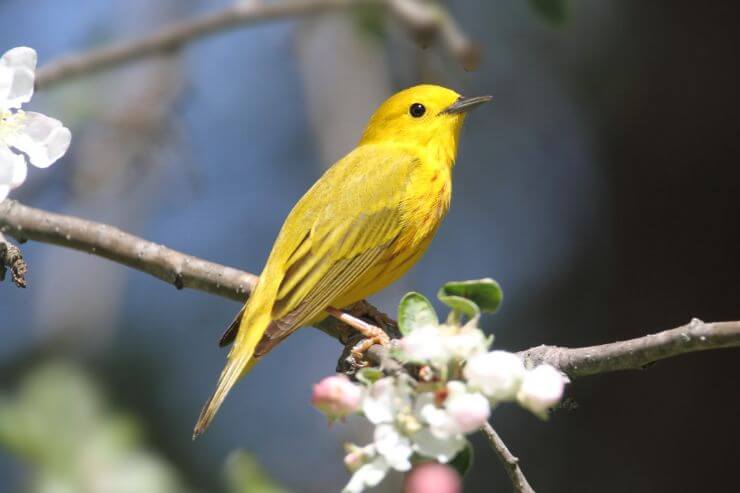
Yellow Warblers craft tidy, cup-shaped nests nestled in shrubs, willow branches, or young trees near streams. The female gathers grasses, plant down, and spider webs to bind the materials. She builds alone while the male sings from perches nearby. An interesting twist is that Brown-headed Cowbirds often target these nests for laying their eggs. Some warblers cover the cowbird eggs with new nest layers and start again, creating a stacked structure that helps protect their own young.
This warbler’s diet centers on insects. Yellow Warblers actively hunt caterpillars, beetles, and spiders among leaves and branches. Their agile movements and sharp eyesight allow them to glean prey from twigs and undersides of foliage. During migration, they may also sample small berries. By consuming large quantities of insects, they play an important role in regulating pest populations. Their constant motion and high-pitched calls make them lively presences in the shrubs they frequent throughout spring and summer.
Conservation of Yellow Warblers has focused on protecting riparian habitats and preserving nesting areas near streams and wetlands. Habitat loss due to development and agriculture has impacted populations in some regions. Despite these pressures, the species remains common across much of its range. Efforts to restore native vegetation and control cowbird parasitism have helped maintain stable numbers. Birders and researchers alike continue monitoring these bright warblers to ensure their cheerful songs endure in future generations.
5. Common Yellowthroat
- Scientific name: Geothlypis trichas
- Life span: Up to 11 years
- Size: 4.3–5.5 in (11–14 cm)
- Weight: 0.3–0.4 oz (9–10 g)
- Wingspan: 5.9–7.5 in (15–19 cm)
- Status: Least Concern
- State status: Breeding and common
- Migratory behaviour: Migrates south by October each year.
The Common Yellowthroat is a familiar sight in wetlands and tangled shrubs across North America, reaching from southern Canada to Central America during migration. Males are especially eye-catching with their rich yellow throats and bright underparts set against olive backs. A bold black mask bordered in white sweeps across their face, giving them a bandit-like look. Females and young birds lack the mask and appear plainer, with warm brown upperparts and soft yellow bellies.
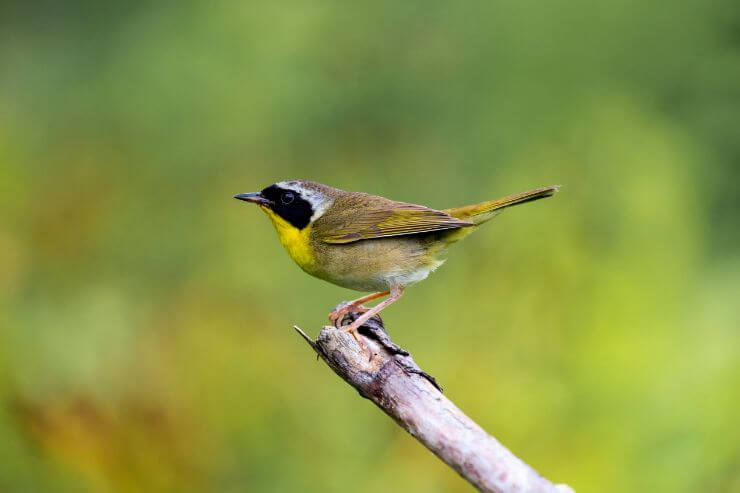
Common Yellowthroats hide their nests low in dense marsh vegetation, often among cattails, reeds, or tangled shrubs. The female selects a concealed site and constructs a cup of grass, bark strips, and leaves, carefully weaving it above ground to avoid flooding. Males stay close by, defending the territory with persistent “witchety-witchety” songs. This secretive nesting strategy helps protect their eggs and chicks from predators like snakes and raccoons that roam wetland edges.
These lively warblers feed primarily on insects and spiders they collect from low vegetation. Common Yellowthroats move with quick hops and flicks of their tails as they hunt. They catch caterpillars, beetles, grasshoppers, and many other invertebrates hidden in leaves or grass. Occasionally, they snap up flying insects in short, darting flights. Their foraging plays a role in keeping insect populations balanced in wetlands and brushy areas where they nest and forage throughout the breeding season.
Throughout their range, Common Yellowthroats have remained fairly abundant due to their ability to use a variety of wetlands and shrubby habitats. Conservation efforts have focused on protecting wetlands from draining and degradation. While some regions have seen declines due to habitat loss, many populations are still secure. Efforts to restore marshlands and limit pollution are important for this species. Continued habitat conservation ensures their masked faces remain familiar sights in marshes and wet thickets.
6. Yellow-rumped Warbler
- Scientific name: Setophaga coronata
- Life span: 5–8 years
- Size: 4.7–5.5 in (12–14 cm)
- Weight: 0.4–0.5 oz (12–13 g)
- Wingspan: 7.5–8.7 in (19–22 cm)
- Status: Least Concern
- State status: Breeding and common
- Migratory behaviour: Returns in late April; departs in fall.
The Yellow-rumped Warbler is one of the most adaptable warblers in North America, found from boreal forests in Canada to open woodlands across the United States. In breeding season, they wear gray backs with bold black streaks, white patches in the wings, and bright yellow flashes on the rump, sides, and crown. Females appear similar but are browner and less vivid overall. During migration and winter, their plumage becomes more subdued, showing pale gray and tan tones.
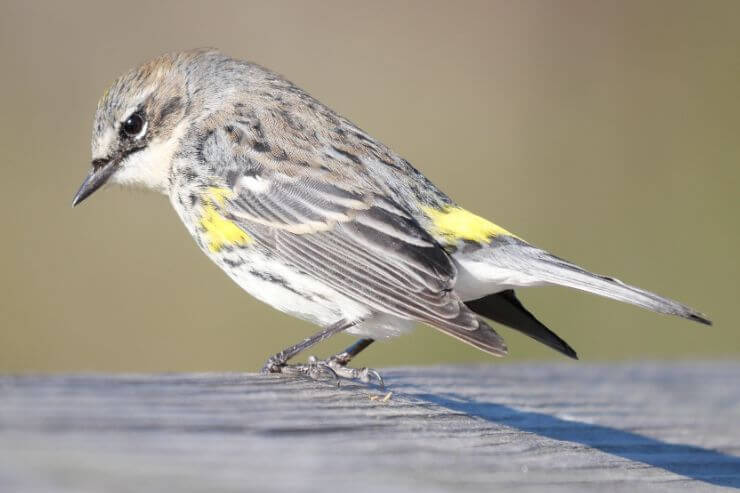
Yellow-rumped Warblers build their nests high in coniferous trees, often near the trunk on a horizontal branch. The female shapes a deep cup of twigs, grasses, and hair, lining it with feathers for warmth. She does most of the work, while the male remains nearby, singing and occasionally bringing food. Their preference for evergreen forests offers both cover and reliable insect hunting grounds. Nest placement varies by region but always provides shelter from predators and harsh weather.
This adaptable warbler’s diet shifts with the seasons. In warmer months, it eats insects such as beetles, caterpillars, and flies, caught by quick sallies or plucked from foliage. In colder weather, Yellow-rumped Warblers are unusual among warblers because they can digest waxy berries from bayberry and juniper. This dietary flexibility allows them to winter farther north than most relatives. At backyard feeders, they sometimes sample suet and fruit, especially during migration and cold snaps.
Conservation history for the Yellow-rumped Warbler has been largely positive. Because they use diverse habitats and have flexible diets, their populations are stable and widespread. They benefit from protected forest lands across their range. While deforestation can affect local breeding success, their ability to winter in varied habitats and exploit berries has helped them adapt. Researchers continue studying their migration patterns to better understand how climate shifts might impact their seasonal movements in the future.
7. Western Meadowlark
- Scientific name: Sturnella neglecta
- Life span: 5–8 years
- Size: 6.3–10.2 in (16–26 cm)
- Weight: 3.1–4.1 oz (88–116 g)
- Wingspan: 16.1 in (41 cm)
- Status: Least Concern
- State status: Breeding and common
- Migratory behaviour: Many leave by late fall; some overwinter locally.
Western Meadowlarks occupy open country from the Great Plains across much of western North America. They look very similar to their eastern cousins, with intricately patterned brown and black backs and bright yellow undersides. The black V-shaped bib across the chest is prominent, helping set them apart from other prairie birds. Subtle differences in facial markings and song help distinguish them. When they perch on fence lines, their clear whistles and vivid colors are unmistakable.

Western Meadowlarks also nest on the ground, weaving cup-shaped nests tucked into thick grass. The female does most of the construction, bending tall stems to create a sheltering arch over the nest. This hidden placement shields eggs and young from view. Males defend territories vigorously, delivering flute-like songs that drift across prairies. Nest sites are often reused in subsequent years if the pair returns and the habitat remains undisturbed and full of insect life.
Their diet consists mostly of insects like grasshoppers, crickets, beetles, and caterpillars during spring and summer. They also eat seeds and grains, particularly in fall and winter when insects are scarce. Western Meadowlarks forage slowly on the ground, using their long, sharp bills to probe and flip leaves. This varied diet allows them to survive in many open landscapes, from grazed pastures to untouched prairies, throughout their wide breeding and wintering range.
Conservation efforts have centered on protecting grasslands from conversion to crops or urban development. While still widespread, Western Meadowlarks have declined where native prairies have been plowed under. Land stewardship programs encourage maintaining or restoring native grasses and wildflowers. Ranchers and conservationists also work together to promote grazing practices that leave habitat intact. These combined efforts are helping sustain healthy populations of this familiar bird across much of the Great Plains and western states.
8. Yellow-headed Blackbird
- Scientific name: Xanthocephalus xanthocephalus
- Life span: 10–12 years
- Size: 8.3–10.2 in (21–26 cm)
- Weight: 1.6–3.5 oz (44–100 g)
- Wingspan: 16.5–17.3 in (42–44 cm)
- Status: Least Concern
- State status: Migratory and occasional
- Migratory behaviour: Gone by September; winters in Southwest U.S., Mexico.
Yellow-headed Blackbirds are striking birds of western marshes and prairie wetlands across much of North America, especially in the western United States and parts of Canada. Adult males are boldly marked with bright golden-yellow heads and breasts contrasting sharply with their deep black bodies and wings. Females look quite different, wearing dull brown plumage with a pale yellow wash on the throat and chest. When gathered in flocks, they create a dramatic, colourful spectacle over cattails.
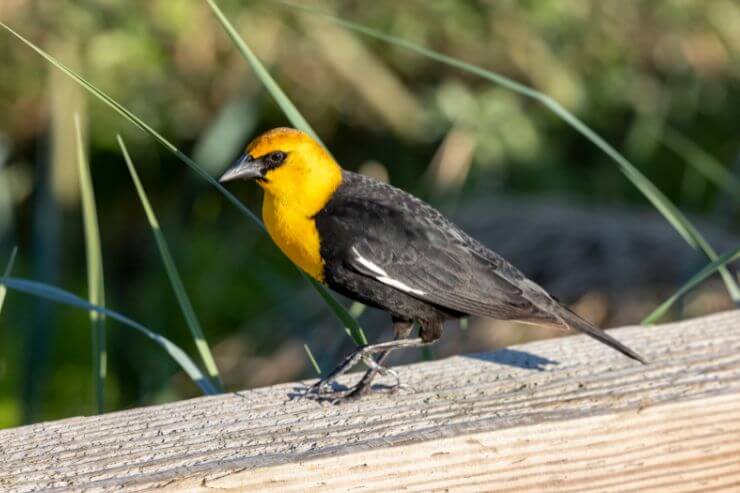
Yellow-headed Blackbirds nest in marshes, where females weave bulky nests over water among cattails and reeds. The platform-like nests are attached to stems, keeping them safely above rising water. Males defend small territories within larger colonies, their loud, creaky calls echoing across wetlands. These colonies can be noisy places full of activity, with multiple pairs raising chicks close together. This social nesting helps protect against predators by offering many watchful eyes and alarm calls.
They mainly eat insects in the breeding season, including aquatic larvae, beetles, and grasshoppers, which they catch along marsh edges. Outside of summer, they form large flocks and switch to seeds and grains from agricultural fields. You’ll often see them gathering with Red-winged Blackbirds, feeding on leftover corn and wheat. This flexible diet helps them survive across seasons. Their foraging habits make them frequent visitors to both wetlands and nearby farmlands.
Conservation efforts for Yellow-headed Blackbirds focus on wetland preservation. Draining marshes for development and agriculture has removed much of their nesting habitat. Restoration projects re-establish cattail stands and improve water quality, encouraging colony return. Because they rely heavily on healthy wetlands, protecting large marsh systems is key to maintaining their breeding populations. Monitoring programs track numbers across their range to ensure these striking blackbirds with golden heads remain a familiar wetland sight.
9. Baltimore Oriole
- Scientific name: Icterus galbula
- Life span: 9-11 years
- Size: 6.7–7.9 in (17–20 cm)
- Weight: 0.99–1.48 oz (28–42 g)
- Wingspan: 9–12 in (23–30 cm)
- Status: Least Concern
- State status: Breeding and common
- Migratory behaviour: Departs by mid-September to Central America.
Baltimore Orioles are admired throughout eastern and central North America, breeding from southern Canada through the central United States. Males are a vivid sight with flame-orange underparts, jet-black heads, and white wing bars that flash when they fly among tall trees. Females are more muted, showing warm yellow-orange bodies and grayish wings. In spring, these orioles return to neighborhood and parks, where their hanging nests and bright colors are a welcome sign of the season.

Baltimore Orioles build elegant hanging nests high in deciduous trees. The female weaves a deep pouch of plant fibers, grass, and sometimes string, suspended from a forked branch. Nest construction takes about a week, creating a secure cradle that sways gently in the breeze. Males guard the area while females work. These beautiful nests are a hallmark of summer woodlands, often visible after leaves fall when their delicate design becomes easier to see.
Their diet is a mix of insects, fruit, and nectar. In spring and summer, they eat caterpillars, beetles, and other insects to fuel nesting and feeding young. Later, they turn to ripe berries and orchard fruit. Baltimore Orioles are also drawn to sugar water feeders and orange halves left out by backyard birders. This varied diet supports them through breeding, migration, and their long journey to Central America in the fall.
Conservation efforts have helped keep Baltimore Orioles stable. Protecting large trees in parks and neighbourhoods ensures nesting sites remain available. Reducing pesticide use preserves insect prey and keeps their food supply healthy. Because they migrate over long distances, conserving tropical wintering grounds is also essential. Public awareness campaigns encourage planting native trees and providing safe foraging areas. Together, these actions support a future where orioles continue to brighten treetops each spring.
10. Orchard Oriole
- Scientific name: Icterus spurius
- Life span: 7–9 years
- Size: 5.9–7.1 in (15–18 cm)
- Weight: 0.6–1.0 oz (16–28 g)
- Wingspan: 9.8 in (25 cm)
- Status: Least Concern
- State status: Breeding and less common
- Migratory behaviour: Migrates south in August to northern South America.
Orchard Orioles breed across much of the eastern and central United States and migrate to Central America for winter. Males are distinctive with rich chestnut-red breasts and bellies, contrasting with their black heads and backs. Females wear a softer look in yellow-green plumage with pale wing bars, blending well among leaves. These orioles often nest in scattered trees and orchards, where their slender shape and gentle, warbling songs can be heard through warm summer mornings.

Orchard Orioles prefer to nest in scattered trees or orchard edges. The female builds a tidy hanging basket woven from grass and lined with finer fibers. She works steadily for several days to finish it, often placing it lower than a Baltimore Oriole’s nest. Males may help collect materials and defend territory. Their nesting habits make them more likely to choose semi-open habitats with young trees or edges where cover and sunlight mix together.
Their diet leans heavily on insects, including caterpillars, beetles, and various other arthropods caught among leaves. During late summer, they also feed on ripe fruits like mulberries and blackberries. Orchard Orioles sometimes sip nectar, especially if flowering trees are nearby. This adaptable menu gives them the nutrients needed for breeding and migration. You’ll often spot them foraging methodically, checking leaves and twigs with quick, deliberate movements before fluttering to the next perch.
Conservation for Orchard Orioles is largely about preserving open woodlands, hedgerows, and orchards. While they remain widespread, habitat loss from intensive agriculture and urban expansion has reduced suitable nesting areas in some regions. Efforts to plant native trees and shrubs and maintain uncultivated field edges help support breeding. Because they winter in Central America, international habitat protection is also important. By keeping a variety of landscapes intact, these colourful orioles continue thriving across their range.
11. Dickcissel
- Scientific name: Spiza americana
- Life span: 3–4 years
- Size: 5.5–6.3 in (14–16 cm)
- Weight: 0.9–1.4 oz (25.6–38.4 g)
- Wingspan: 9.8–10.2 in (24.8–26 cm)
- Status: Least Concern
- State status: Breeding and common
- Migratory behaviour: Leaves by late August for Venezuela, northern South America.
Dickcissels are grassland birds found mainly across the central United States during breeding season, especially in prairies and hayfields. Males display a bold yellow breast marked by a black throat patch and a sturdy, finch-like bill. Their grayish backs are streaked with brown, and their bright yellow eyebrow gives them a lively look. Females are paler and lack the black throat, but they still show a hint of yellow on the face and chest.
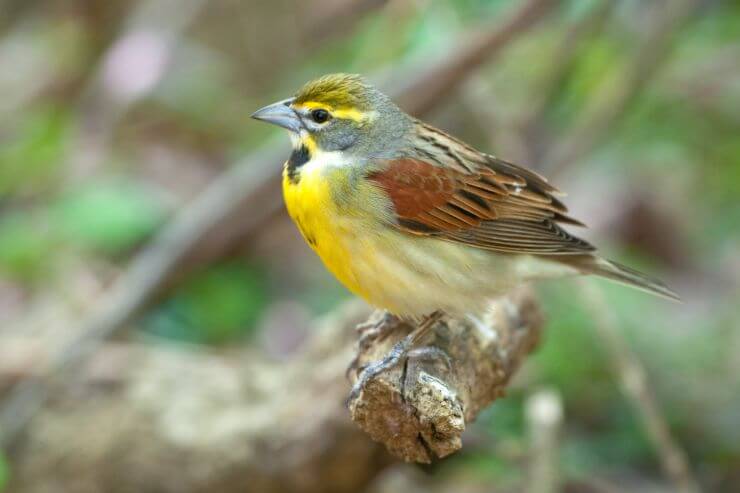
Dickcissels build their nests low in dense grasses or shrubs, weaving an open cup of grass and lined with finer materials. The female does most of the construction while the male sings persistently from tall perches nearby, claiming territory. Nests are often hidden well among stems, making them hard to spot even in open fields. This careful concealment helps protect eggs and chicks from predators and the elements until the young are ready to fledge.
They eat seeds most of the year, especially in fall and winter when insects are scarce. During breeding season, they switch to a diet richer in grasshoppers, beetles, and caterpillars. This protein boost supports egg-laying and chick growth. Dickcissels forage by moving deliberately through grasses and perching to pick seeds. Their sturdy, conical bills make them effective at cracking seeds. Watching them feed in flocks is a common sight in prairies and weedy fields.
Historically abundant in prairies, Dickcissels declined when grasslands were plowed for crops. Conservation has focused on preserving native prairie remnants and restoring grassy habitats. Programs that encourage delayed mowing and prairie management help ensure nesting success. Because they winter in Venezuela and other parts of South America, international conservation agreements play a role in protecting their habitats. Monitoring population trends remains important to keep these distinctive grassland singers from further decline.
Where to look for Yellow birds in Missouri
If you’re hoping to see Missouri’s yellow birds up close, you’re in luck, many of them can be found without much effort if you know where to look. Start by paying attention to the edges of prairies and meadows. These open areas are perfect for spotting Western Meadowlarks and Dickcissels perched on fence posts or tall grass, singing their bright, whistling songs. Wooded trails and riversides are also rich with color in the warmer months. Here, you might catch glimpses of Baltimore Orioles weaving their hanging nests high in the trees or Yellow Warblers flitting through willows along the water.
Bring a pair of binoculars and walk slowly, watching the treetops and listening for high, clear calls. Early mornings are usually best, when birds are most active.
Four great places to look for yellow birds in Missouri are:
- Prairie State Park near Mindenmines, where meadowlarks and Dickcissels fill the tallgrass prairie with song.
- Tower Grove Park in St. Louis, a reliable spot for migrating warblers and orioles in spring.
- Riverlands Migratory Bird Sanctuary north of St. Louis, with wide wetlands and cottonwoods.
- Mingo National Wildlife Refuge, offering rich habitats for warblers and Common Yellowthroats.
Conclusion
Yellow birds bring a splash of brightness to Missouri’s fields, wetlands, and backyards, reminding us how diverse and lively our natural spaces can be. Whether you’re watching goldfinches at your feeder or spotting a warbler along a quiet trail, these colourful species offer countless moments of wonder. By learning about their habits and habitats, we can all play a part in protecting them so their vivid colors and songs remain part of Missouri’s landscapes.


